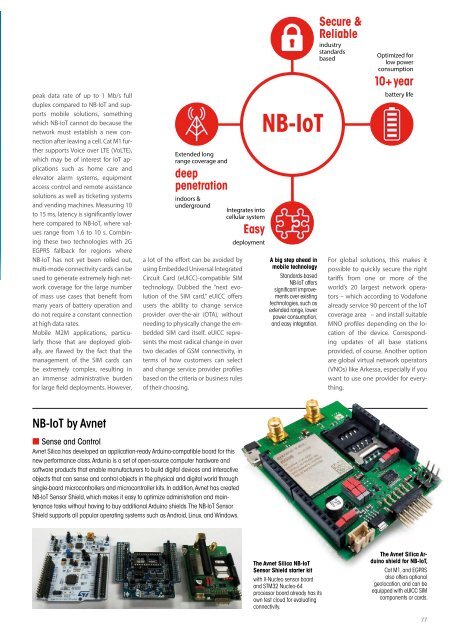Smart Industry 2/2018
Smart Industry 2/2018 - The IoT Business Magazine - powered by Avnet Silica
Smart Industry 2/2018 - The IoT Business Magazine - powered by Avnet Silica
You also want an ePaper? Increase the reach of your titles
YUMPU automatically turns print PDFs into web optimized ePapers that Google loves.
peak data rate of up to 1 Mb/s full<br />
duplex compared to NB-IoT and supports<br />
mobile solutions, something<br />
which NB-IoT cannot do because the<br />
network must establish a new connection<br />
after leaving a cell. Cat M1 further<br />
supports Voice over LTE (VoLTE),<br />
which may be of interest for IoT applications<br />
such as home care and<br />
elevator alarm systems, equipment<br />
access control and remote assistance<br />
solutions as well as ticketing systems<br />
and vending machines. Measuring 10<br />
to 15 ms, latency is significantly lower<br />
here compared to NB-IoT, where values<br />
range from 1.6 to 10 s. Combining<br />
these two technologies with 2G<br />
EGPRS fallback for regions where<br />
NB-IoT has not yet been rolled out,<br />
multi-mode connectivity cards can be<br />
used to generate extremely high network<br />
coverage for the large number<br />
of mass use cases that benefit from<br />
many years of battery operation and<br />
do not require a constant connection<br />
at high data rates.<br />
Mobile M2M applications, particularly<br />
those that are deployed globally,<br />
are flawed by the fact that the<br />
management of the SIM cards can<br />
be extremely complex, resulting in<br />
an immense administrative burden<br />
for large field deployments. However,<br />
Extended long<br />
range coverage and<br />
deep<br />
penetration<br />
indoors &<br />
underground<br />
a lot of the effort can be avoided by<br />
using Embedded Universal Integrated<br />
Circuit Card (eUICC)-compatible SIM<br />
technology. Dubbed the “next evolution<br />
of the SIM card,” eUICC offers<br />
users the ability to change service<br />
provider over-the-air (OTA), without<br />
needing to physically change the embedded<br />
SIM card itself. eUICC represents<br />
the most radical change in over<br />
two decades of GSM connectivity, in<br />
terms of how customers can select<br />
and change service provider profiles<br />
based on the criteria or business rules<br />
of their choosing.<br />
Integrates into<br />
cellular system<br />
Easy<br />
deployment<br />
NB-IoT<br />
A big step ahead in<br />
mobile technology<br />
Standards-based<br />
NB-IoT offers<br />
significant improvements<br />
over existing<br />
technologies, such as<br />
extended range, lower<br />
power consumption,<br />
and easy integration.<br />
Secure &<br />
Reliable<br />
industry<br />
standards<br />
based<br />
Optimized for<br />
low power<br />
consumption<br />
10+ year<br />
battery life<br />
For global solutions, this makes it<br />
possible to quickly secure the right<br />
tariffs from one or more of the<br />
world’s 20 largest network operators<br />
– which according to Vodafone<br />
already service 90 percent of the IoT<br />
coverage area – and install suitable<br />
MNO profiles depending on the location<br />
of the device. Corresponding<br />
updates of all base stations<br />
provided, of course. Another option<br />
are global virtual network operators<br />
(VNOs) like Arkessa, especially if you<br />
want to use one provider for everything.<br />
NB-IoT by Avnet<br />
■ Sense and Control<br />
Avnet Silica has developed an application-ready Arduino-compatible board for this<br />
new performance class. Ardunio is a set of open-source computer hardware and<br />
software products that enable manufacturers to build digital devices and interactive<br />
objects that can sense and control objects in the physical and digital world through<br />
single-board microcontrollers and microcontroller kits. In addition, Avnet has created<br />
NB-IoT Sensor Shield, which makes it easy to optimize administration and maintenance<br />
tasks without having to buy additional Arduino shields. The NB-IoT Sensor<br />
Shield supports all popular operating systems such as Android, Linux, and Windows.<br />
The Avnet Silica NB-IoT<br />
Sensor Shield starter kit<br />
with X-Nucleo sensor board<br />
and STM32 Nucleo-64<br />
processor board already has its<br />
own test cloud for evaluating<br />
connectivity.<br />
The Avnet Silica Arduino<br />
shield for NB-IoT,<br />
Cat M1, and EGPRS<br />
also offers optional<br />
geolocation, and can be<br />
equipped with eUICC SIM<br />
components or cards.<br />
77
















